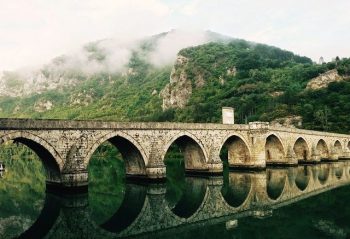Guizhou Province: the world’s bridge museum Posted by Ayana on Jun 15, 2020 in Uncategorized
The landlocked province of Guizhou (贵州 Guìzhōu) is situated in southwest China.
The Chinese describe the province as:
天无三日晴, tiān wú sān rì qíng,
地无三里平, dì wú sān lǐ píng,
人无三分银。 rén wú sān fēn yín.
The rhymed parallelism depicts it well. The first part describes the sky and indicates the weather: 天无三日晴 (tiān wú sān rì qíng), meaning a sky without three sunny days. The province has indeed lengthy cloudy rainy days, and little sunshine. The capital, Guiyang, for example, has more than 260 rainy cloudy days in an average year. The sky is mostly drizzling all year long, and even the summer months are cloudy.
The third part describes the people, focusing on their economic situation: 人无三分银 (rén wú sān fēn yín), meaning people without three pennies. Although the province is rich in natural resources, such as precipitation, timber, coal, and minerals, it is considered relatively poor. Guizhou is one of the most disadvantaged and poverty-stricken areas of China. It has one of the lowest GDP (gross domestic product ) per capita in the country.
The second part describes the land, indicating its geographical surface: 地无三里平 (dì wú sān lǐ píng), meaning a land without three flat li (a Chinese unit of length). Guizhou is probably the most mountainous province in China. With 80% of the land covered by mountains and 10% by water, the Chinese usually refers to Guizhou as the province without a plain:
贵州是一个没有平原的省份。
Guìzhōu shì yī gè méi yǒu píng yuán de shěng fèn.
Guizhou is a province without plains.
The province’s landscape, integrating mountains, rivers, waterfalls, caves, lakes and forests, creates a unique scenery, but this topography makes transportation a problem. The mountainous province is covered by towering mountains (崇山峻岭 chóng shān jùn lǐng), as shown in the next video:
To connect between the villages, more than 20,000 bridges crossing the rivers and canyons were built throughout the province. The Wind and Rain Bridges (风雨桥 fēng yǔ qiáo), for example, became one of Guizhou’s tourist attractions. Designed by local carpenters of the Dong minority, these wooden bridges have social meaning beyond being architectural monuments. The multiple pavilions on the bridges provide the locals an excellent place to meet and socialize. Amazing footages of these bridges can be seen in the next video:
Some of the longest arch bridges in the world are located in Guizhou. Najiehe Railway Bridge and Zongxihe Bridge, for example, with their red long arches. Some of the highest suspension bridges in the world are located in Guizhou. Dimuhe Bridge and Balinghe Bridge, for example. On December 2019, a new cable-stayed bridge called Pingtang Bridge, the second-tallest bridge in the world, was opened to traffic.
贵州公路桥梁类型众多。
Guìzhōu gōng lù qiáo liáng lèi xíng zhòng duō.
Guizhou has numerous types of bridges.
The vast numbers, various types and complex technologies of the bridges gave the province the title the world’s bridge museum (世界桥梁博物馆 shì jiè qiáol iáng bó wù guǎn).
多山的地貌让桥成为贵州独特的符号。
Duō shān de dì mào ràng qiáo chéng wéi guì zhōu dú tè de fú hào.
The mountainous landscape makes the bridges unique symbol of Guizhou.
Text vocabulary
平原 píng yuán = plain
省份 shěng fèn = province
崇山峻岭 chóng shān jùn lǐng = high mountains and precipitous ridges
桥梁 qiáol iáng = bridge
类型 lèi xíng = type
博物馆 bó wù guǎn = museum
地貌 dì mào = landscape, landform
符号 fú hào = symbol, mark
好好学习,天天向上!

Build vocabulary, practice pronunciation, and more with Transparent Language Online. Available anytime, anywhere, on any device.





Leave a comment: